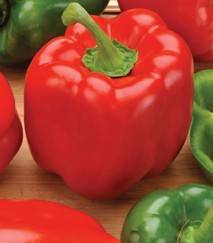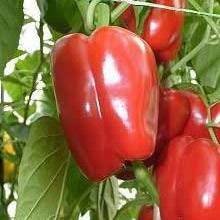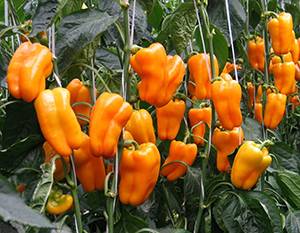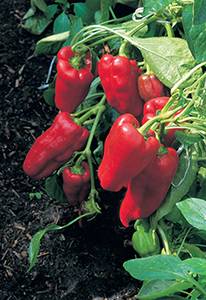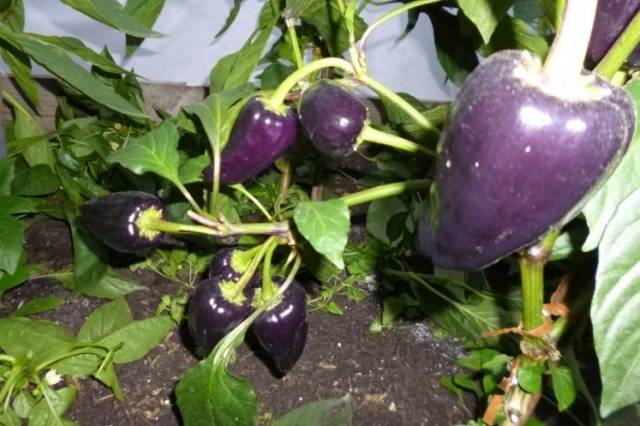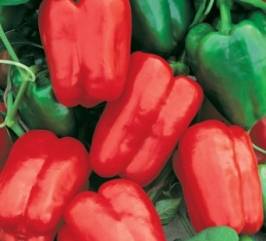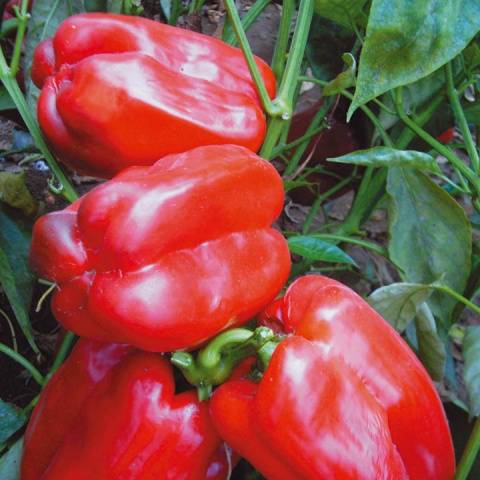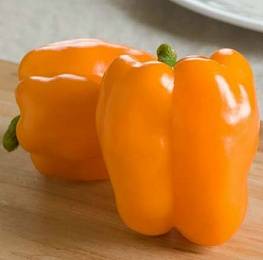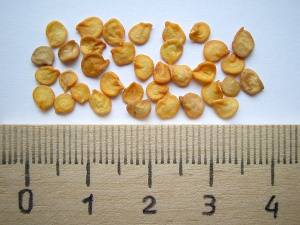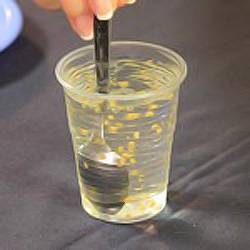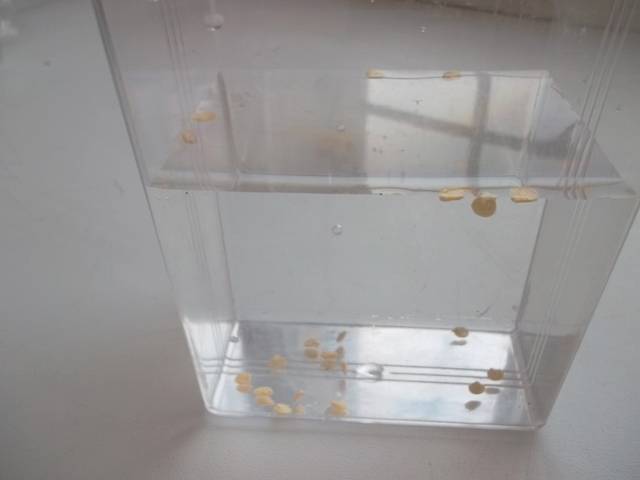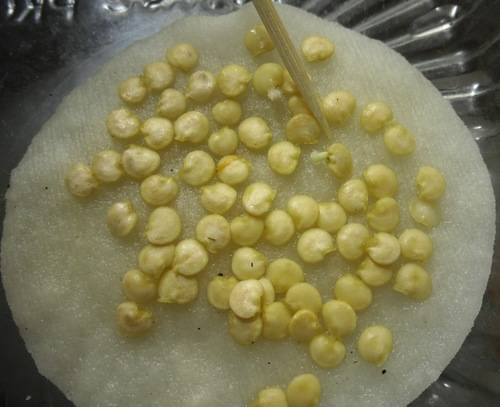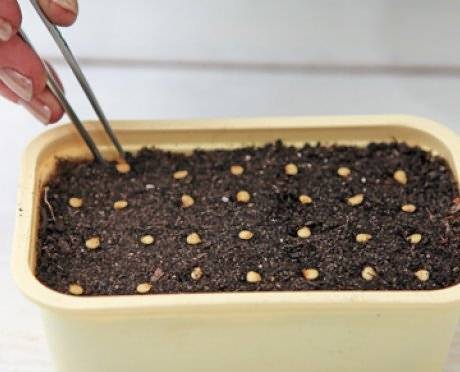By choosing bell pepper seeds, suitable for salads, it is best to pay attention to thick-walled varieties... Such peppers have a very juicy and tasty wall, which is used for food. Thick-walled peppers intended for use in salads, as well as for cooking and winter preparations. They are good stuffed and lecho.
Pepper varieties zoned by region, therefore, when choosing planting material, you need to pay attention to what area a particular variety is intended for. If liberties are still permissible for the southern regions, then with the northern ones everything is somewhat more serious due to the too short summer period.
It is better for northerners to take early and mid-season varieties of pepper produced by agricultural firms in their regions.
Pepper seeds sweet early thick-walled beyond the Urals is offered by the firms "Uralsky Dachnik" and "Seeds of Altai".
Early maturing pepper varieties
From the firm "Uralsky Dachnik"
Turquoise
Early maturing variety. From planting seedlings to fruiting, 75 days pass. Pericarp thickness up to 10 mm. The fruit is cuboid, almost the same in height and width, with sides of 11 by 11 cm. Ripe fruits are red.
Atlantic F1
Actually, a hybrid of a foreign selection from the Seminis company. It is offered by Uralsky Dachnik for sale in the northern regions due to the harvest ripening period of 70 days. The peppers are very large, weighing up to 400 g. The pericarp is 9 mm thick. The planting density of this variety is recommended 2 bushes per sq. m.
Magnificent century
Early maturing variety. The shape of the peppers is very convenient for stuffing... The sizes are also almost ideal for this purpose, since the fruits are medium, weighing up to 180 g. Pericarp up to 12 mm.
Hercules
Early maturing variety. Before the harvest, 95 days pass from germination. Peppers are cuboid, up to 12 cm long. The thick-walled ones are "on the verge". The pericarp thickness is on average 6 mm.
Drive F1
Early ripe hybrid Dutch breeding, intended for cultivation in greenhouses. Pepper of a dark yellow color has a length of up to 17 cm and a weight of up to 200 g. Pericarp is up to 1 cm thick. This is one of the largest and thickest peppers among the colored varieties. The fruits are formed consistently, allowing you to harvest from one bush for quite a long time.
Highway F1
It is one of the earliest varieties of pepper. It brings the harvest in the middle of summer. The peppers are not very beautifully shaped, which is a curved prism. Large, weighing from 180 g and up to 14 cm long. The pericarp is 7 to 11 mm thick. The hybrid is resistant to adverse weather conditions and top rot. Differs in high productivity.
The firm "Uralsky Dachnik" is practically the only one that offers really early ripening varieties of sweet peppers, taking into account the region. The rest of the Trans-Ural companies offer early-maturing varieties with a ripening period of at least 100 days.
Residents of the southern regions of Russia, as well as residents of Ukraine, Moldova and Belarus, have a much wider choice of sweet thick-walled peppers. They can grow early varieties of peppers with a ripening period of 100 to 110 days. In Siberia, such varieties should already be classified as mid-season.
Firm "Aelita" offers early ripe varieties of thick-walled peppers with a fruiting period of 115 days. This company carries out only wholesale deliveries. Her seeds can be found in other specialty stores.
Big Daddy
Selection of the firm "Aelita". Thick-walled (pericarp up to 8 mm) early ripening variety with peppers ripening up to 120 days. Fruits of an interesting purple color weighing up to 100 g. A universal variety. Very good for stuffing.
Big gold
Early maturing variety. The crop can be harvested 95 days after planting. Peppers weighing 200 g Wall up to 8 mm thick. Ripe peppers have a beautiful golden yellow color. The variety is universal.
Firm "SeDeK" offers early maturing varieties:
Annushka F1
Ripening period up to 110 days. The peppers are prismatic, weighing 200 g. The walls of the pod are 6 mm thick. Very productive. Gives up to 7 kg per sq. M. The hybrid is offered for culinary processing and fresh consumption.
Apollo F1
An early ripe hybrid with a ripening period of 105 days. It can grow and bear fruit in open and closed ground. Fruits are large, prismatic, weighing up to 200 g. Pericarp 8 mm thick. The variety is valuable for its high yield (7 kg per square meter) and good keeping quality. The appointment is universal.
Western
Early maturing (100 days) variety with medium-sized fruits weighing up to 100 g. Pericarp 7 mm thick. Pepper variety for universal use. Recommended for salads and culinary processing. The advantages of the variety are: amicable fruit formation, resistance to top rot and high yield.
Jack
An early ripe (110 days) variety with large, bright orange fruits in a ripe state weighing up to 200 g. It is intended for growing in open beds and in greenhouse conditions. The purpose of the variety is universal.
The choice of pepper seeds today is very large, you can hardly buy everything you want, simply because there is not enough space in the beds. Pepper seeds have not been stored for more than five years. At the same time, they gradually lose their germination. You should take this point into account if you want to buy seeds "next year".
Sowing preparation
When buying seeds, first of all, you need to give preference to the seeds of proven manufacturers. Whether to save money by buying cheaper seeds is up to the summer resident himself, but certain points should be taken into account.
Expensive seeds from well-known manufacturers are treated with antifungal drugs, microelements and growth stimulants in preparation for sale. This is usually indicated on the packaging. These seeds are brightly colored, often in a "firm" color, and are completely ready for planting. All that needs to be done with such a seed is to put it in a seedling container and sprinkle it with earth.
Home-grown or non-branded cheap seeds need pre-planting treatment, as they can be infected with pathogenic microflora.
Germination test
There is always a risk of buying low-quality seed material and missing out on the most favorable days for planting. In order not to waste time when you need to plant seeds for seedlings, it is better to check them for germination in advance. To do this, several grains are taken for a sample from the purchased bags, they are tied in a cloth and placed in water with a temperature of + 25 ° C for a day. A day later, they take it out, put it right with a bundle on a pallet and put it in a warm place for 4 days.
After that, the seeds are planted in the ground and wait for germination, maintaining the moisture and high temperature of the soil.
Calibration
After finding out the quality of the seeds and if they are worth the time, the seeds need to be calibrated. In simple terms, select the best. Not all grains will sprout. Some of them may just be empty. For sowing, medium-sized seeds are usually selected, sifting out too small and too large.
Salt water calibration
You can identify empty achenes by placing the seeds in a salt solution. To do this, put 30 - 40 grams of sodium chloride per liter of water. The expression "three-, four percent" salt solution can be found. Or 30-40 ‰ (ppm). They are all the same. Especially considering that chemical precision is not required in this case.
Dip the seeds into the solution and stir slightly so that they are moistened with water. After 7 - 10 minutes, good seeds will settle to the bottom, and empty achenes will remain at the top, which must be collected and discarded.
Not all gardeners like this method, since they believe that not only empty achenes remain at the top, but also overdried seeds. Here the choice is up to the owner of the seeds. In fact, with a soggy upper peel, you can even feel by touch if there is a seed in the achene or if it is completely empty.
Good seeds should be removed from the saline solution, rinsed with fresh water and dried thoroughly.
Disinfection
After calibration, it is necessary to dress the seeds in a 2% solution of potassium permanganate, provided that the seeds have not been previously treated by the manufacturer.
Seeds, wrapped in a linen bag, are immersed in a solution of potassium permanganate for half an hour. After disinfection, they are washed with water and dried.
Instead of potassium permanganate solution, special fungicidal preparations can be used. In this case, the seeds are etched according to the instructions attached to the preparation.
Processing with microelements
There is an opinion that such treatment improves seed germination, increases resistance to diseases and adverse weather conditions. However, given that usually peppers are grown through seedlings that are kept indoors, the thesis about bad weather conditions is controversial.
At home, such processing is carried out using an infusion of wood ash, which contains about 30 trace elements necessary for pepper.
20 grams of ash, diluted in 1 liter of water, is infused for 24 hours. Then a bag of seeds is placed in the infusion for 5 hours. After a while, the peppercorns are taken out, washed again with water and dried.
When using commercial formulations, the seeds are processed according to the instructions.
Growth stimulants
Before planting, seeds are treated with a purchased or improvised stimulant to accelerate germination and improve germination. At home, boiled nettle is considered the best growth stimulant. 1 tbsp. spoon of nettle in a glass of boiling water. Purchased ones are applied according to the instructions.
In the growth stimulator, the seeds are soaked for 1 hour. After that, you can plant them in the ground or carry out an additional procedure.
Soaking before sowing
After the performed manipulations, the seeds can be laid out on a wet rag or foam rubber and wait until they swell. Considering that before this, the pepper grains had already got wet, then dried up for a good quarter of a day, and the shell softened, they will swell quickly. Swollen peppercorns can be planted in a seedling container or left on damp material until the spine hatches, and the seeds that have already hatched can be planted. The moisture level of the foam rubber or cloth must be constantly monitored.
The peppercorns lagging behind in development are thrown away.
Bubbling
Instead of soaking and sprouting pepper seeds in a damp material, bubbling can be used.
For pepper grains, bubbling is carried out within a day - one and a half. This method allows you to saturate the seeds with oxygen. It is essentially a "seed jacuzzi". It is easy to make at home with a conventional aquarium air compressor.
The first video shows how to make a bubbling device from a regular two-liter plastic bottle.
Sparging can be combined with soaking the peppercorns in a solution of trace elements or a growth stimulant. Then from the preparation of seeds for sowing, it will be possible to remove at least two, or even three operations (if you add trace elements and a growth stimulator to the water).
Sparging does not have to be done in a device like the first video. You can put the air atomizer from the compressor in a regular can. In this case, it will be clearly visible when the seeds are saturated with water and oxygen, become heavy and sank to the bottom. In the first case, you will not be able to see this.
Bubbling is carried out at a water temperature of 21 ° C. If the seeds begin to hatch, the compressor is stopped and the seeds are planted in the soil. Or placed in a refrigerator for quenching.
Hardening
After germination, seeds can be refrigerated for 3 days to 1 week. This procedure helps the peppercorns to more easily adapt to temperature extremes in the future and it is easier to transfer the transplanting seedlings into open ground.
After hardening, the pepper grains are placed in a seedling container filled with soil and sprinkled with earth on top. You can do this even before hardening, after the soaking step.
This is the torment of the gardener with seed preparation sweet pepper for sowing run out. Next, the growing of seedlings begins.
